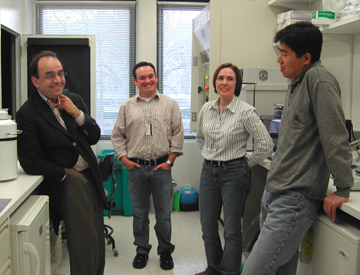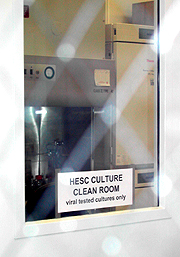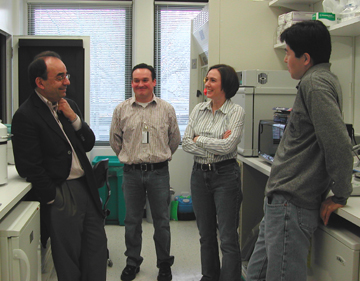
| T H E N I H C A T A L Y S T | M A R C H – A P R I L 2004 |
|
|
|
From
Art to Science
|
by Celia Hooper |
 |
|
Stem
Cell–Mates:
(left to right) Ron McKay and three of the four NINDS scientists who are
characterizing, comparing, and defining protocols for growing cell lines
available in the NIH stem cell registry: Richard
Pitts, Barbara
Mallon, and Kye-Yoon
Park
|
At this stage, the mission of NIH’s new Stem Cell Unit is a little like the cells it studies. For both pluripotent stem cells and the unit, life boils down to the basics—laying down foundations and definitions.
The unit, which grew its first human embryonic stem (ES) cell early last August, was established within NINDS, but with outward-looking and increasingly ambitious goals, which start with accurate definition of the characteristics of pluripotent human ES cells and how to grow them.
Within a year, the unit expects to produce a body of knowledge that will define and enhance the usefulness of most of the human ES cell lines that can be studied with federal funds.
When The NIH Catalyst visited in early March, the unit consisted of four scientists, supervised by NINDS senior investigator Ron McKay, whose lab (molecular biology) had previously worked on mouse embryo stem cells and neuronal precursor cells. Key benchmarks in the unit’s development thus far include:
![]() Acquisition of 13 of the 17 currently approved human ES cell lines that are
most readily available for federally supported research
Acquisition of 13 of the 17 currently approved human ES cell lines that are
most readily available for federally supported research
![]() Bringing six of the cell lines into active culture and beginning to define protocols
for their growth (the others will be moved from freezer to culture within the
year)
Bringing six of the cell lines into active culture and beginning to define protocols
for their growth (the others will be moved from freezer to culture within the
year)
![]() Rederivation of one colony from a single cell—that is, the cloning of a
homogeneous stem cell population from a single cell
Rederivation of one colony from a single cell—that is, the cloning of a
homogeneous stem cell population from a single cell
"If you are not able to clone a genetically homogeneous pure population from a single source, you cannot do anything—no genetics, no biology," McKay comments on the unit’s latest accomplishment.
"Our being able to subclone the cells is a really important step forward. There are not very many people in the world who can casually say they can subclone human ES cells—and, actually, it wasn’tvery obvious to us a month ago that we could do it."
Scientists around the world have been dazzled by the potential and realized properties of ES cells—including their ability to be propagated abundantly and indefinitely before being induced to differentiate into almost any cell type in the human repertoire. They hope to capitalize on these properties in the future, transplanting the cells into patients to replace diseased, damaged, and degenerating tissues otherwise beyond therapy.
 |
|
The
Inner Sanctum:
laminar flow hood where the team cultures the human embryonic stem cells
|
A
Matter of Definition:
Cells
and Protocols
But at this point, the unit’s raison d’être is more mundane, albeit critical:
![]() To ensure that the cells are pathogen free
To ensure that the cells are pathogen free
![]() To ensure they have normal karyotypes
To ensure they have normal karyotypes
![]() To define common properties of the cells
To define common properties of the cells
![]() To define standard operating procedures for growth
To define standard operating procedures for growth
The unit hopes to turn what has been a notoriously difficult art into a reproducible science. "That’s why this group exists," says McKay.
The unit’s researchers, each of whom is responsible for growing a couple of the cell lines, note that the initial stocks of cells arrived with five different sets of instructions from five different suppliers—Wisconsin Alumni Research Foundation (WiCell Research Institute) in Madison, Wisc.; the University of California at San Francisco; BresaGen, Inc., in Athens, Ga.; MizMedi Hospital–Seoul National University in Korea; and Technion–Israel Institute of Technology in Haifa.
"This is a classic example of a little ‘local culture.’ Each of these groups has independently developed factors to grow their cells," McKay observes.
Their differences may be more perceived than real, the group agrees, and a goal of the unit is to test out each protocol, refining as they go, and see whether there may be a single common protocol that will work for all lines.
It also may be that differences in culture protocols are actually important for the different cell lines, McKay says. Very slight differences in the timing of the initial derivation of the cells, or slight genetic differences between them, may lead to real differences in how the cells respond to different conditions. Over multiple passages or replating of cells, selection of certain cells—for example, those that grow more quickly—could also be driving a sort of evolutionary diversification of the cell lines or even selecting for cells more prone to oncogenesis.
By attempting to define a standard protocol and a standard cell—colonies from a single, cloned cell—the unit hopes to discern any real differences in nature vs. nurture for the cell lines.
The team will also experiment with ways to reduce culture variability attributable to feeder layers or other imperfectly defined components of the growth media.
"There’s another cell in this whole game, and that’s the mouse fibroblast," the feeder layer on which the human cells are grown. "We’ve talked to people who make human ES cells who say that if they fail it’s because batches of mouse fibroblasts fail," McKay says.
The team will be prospecting for factors that optimize growth, including what they refer to as the "mystery factor" in mouse fibroblast cells. They will also experiment with growing cells without a feeder layer.
Establishing this bedrock foundation for defining cells and protocols is critical for human ES cell research, McKay says. "It’s critical that you know where you started" for any subsequent experiments with the cells. The unit, he says, will provide access to a "common, normal cell."
He likens the importance of standardization of stem cells and their growth protocols to having standards for measurement of distance or purification of enzymes in the golden age of enzymology.
"If you don’t know what cells you’ve got, you don’t have a field."
 |
|
Ron McKay (left) extolls the efforts and caliber of his Stem Cell Unit team (present are Richard Pitts, Barbara Mallon, and Kye-Yoon Park) Support to establish the NIH Stem Cell Unit came from the NIH director’s discretionary fund; most of the NIH intramural programs contribute to its continuing support. The scope of the unit’s budget and research is overseen by a steering committee comprised of leading intramural and extramural stem cell biologists. |
Shifting Sands of Stem Cell Research
The Stem Cell Unit’s attempt to lay this foundation comes at a time when human ES cell research is undergoing massive shifts. The day before The Catalyst visited the unit, the New England Journal of Medicine prepublished an article online that details the establishment of 17 new human ES cell lines by Harvard’s Doug Melton and colleagues ("Derivation of Embryonic Stem-Cell Lines from Human Blastocysts"). Because the cells were extracted after the August 9, 2001, cutoff date for human ES cells that may be studied with federal funds, the Harvard group used private funds and facilities for their work—something that must also be done by any investigators seeking to use these new cell lines for their own stem cell research.
In an editorial accompanying the report, NEJM editors refer to the cell lines available in the NIH registry as "reportedly difficult to obtain, difficult to maintain, or poorly characterized," and they urge that Melton’s cell lines become part of the NIH registry for NIH-funded researchers.
These problems underscore the urgency of the unit’s mission, which will maximize the usefulness of the cell lines available for federal funding.
"Particularly now," McKay says, "when there’s a very limited number of lines that can be used with NIH funds, there’s an obligation on us to check them, to compare them, to determine their basic properties: Do they grow? Are they normal? We exist to ensure that human ES cells are grown in the right way and can be expanded in large numbers."
"And this group of people," McKay raves, pointing to his colleagues, "is the only group of people in the world who are doing this." By the end of the year, he says, 13 of the federally approved cell lines will be under study in the unit.
The Quest for Stability
Having a predictable standard cell will also be critical down the road. Researchers have begun to report that some of the federally approved stem cell lines are showing signs of chromosomal instability—for instance, picking up an extra chromosome after a large number of passages. McKay stresses that karyotypic instability would not be acceptable for therapeutic cells transplanted into patients.
Thomas Ried, NCI’s chief of cancer genomics in the Center for Cancer Research, has collaborated with the unit to do spectral karyotyping on a half-dozen of the cell lines. So far, he says, "the majority showed a normal karyotype. Only one showed a gain of chromosome 17." Ried considers karyotyping a "very important and reasonable first step to test the genomic integrity of these cells."
McKay says the intense focus on refining and defining the ES cell "is just the beginning." Beyond karyotyping, the unit will probe for more subtle genetic changes in the cells.
"We’re looking at gene expression by antibody techniques and by PCR. We’re interested in learning whether these cells express transcription factors we know to be involved in early differentiation . . . . How you grow the cells will be linked, one assumes, to the levels of expression of these different genes.
"And we’ll be able to tell people, ‘if you grow this cell type this way, it will have the following properties—and when you put it through the FACS machine, you’ll see this profile.’"
Vive la Différence
In the years ahead, the unit will move toward characterizing and standardizing procedures for differentiating the cells—applying growth factors to induce them to grow into potentially transplantable therapeutic cells. Thus far, and following closely McKay’s research on mouse ES cells, the main efforts in differentiating the human cells have been steering them toward neuronal development, including production of dopamine-secreting neurons.
Prospects also "look promising" in terms of endodermal differentiation, McKay says, noting that "we can make endoderm pretty efficiently" and that a cell of particular therapeutic interest—the pancreatic islet cell—arises from endoderm.
McKay’s murine ES cell research also points to oligodendrocytes and multiple sclerosis as tempting future targets for differentiating ES cells. "The oligo precursor is easy to grow and easy to expand, and when we put these oligos back into the brain of a rat model of human disease, they made very nice myelin. So when you think of the first clinical uses of human ES cells—in, say, two to three years—you might think of oligodendrocytes and the multiple sclerosis program [at NINDS]. I talk with Roland Martin [at NINDS] about this."
McKay starts listing others on campus with whom he talks shop—among them Pam Robey (NIDCR, mesenchymal stem cells), David Bodine (NHGRI, hematopoietic stem cells), Cindy Dunbar (NHLBI, clinical hematopoietic stem cell transplantation)—an emerging cell therapy network of basic and clinical investigators with an eye toward the future (see box, this page).
Perhaps more immediately than human therapy, McKay says, will be use of the ES cells for basic research to study the effects of gene manipulations on specific tissues and development that cannot currently be studied in vitro. This work is closely allied to gene therapy, which may also profit from careful ES cell groundwork. He again stresses the importance of having a genetically defined starting material for such research. "Garbage in, garbage out," he says flatly.
With the Click of a Mouse
With standardization efforts over the next two to three years, McKay expects researchers will feel secure about the predictability of human ES cells.
The unit plans to help other NIH stem cell labs by publishing standard operating procedures and data characterizing the cells on its website.
They will also share specific expertise on acquiring and growing the different cell lines with individual labs. Although growing large numbers of undifferentiated cells is very labor intensive, McKay says at least obtaining the knowledge of how to get and grow the cells should not be, if the unit does its job.
"We want to make
it easy." ![]()
| STEM
CELL
USERS
GROUP
LOOKS TO
A FUTURE FOR CLINICAL STEM CELL RESEARCH |
|
In a parallel and complementary vein, efforts are under way to coordinate the efforts of NIHers pursuing all varieties of potential clinical applications of stem cell research. In February, Betsy Nabel, NHLBI's director of clinical research programs, assembled scientists studying all types of stem cells—including hematopoietic, mesenchymal, and other multipotent cells from adults. An emphasis of the group will be on translational and clinical research. Intramural investigators who would like to participate in this group to share ideas, expertise, reagents, or techniques should contact Sandy Moyer to be added to the group's e-mail list. Although human embryo stem cells are still far from ready for investigations in patients, protocols using adult stem cells are already under way at NIH. The new users group hopes that efforts now to coordinate resources and teamwork for adult stem cell research will pave the way when embryo stem cell research is ready to go clinical. The group has two working committees. The first, led by Elizabeth Read and Kathy Zoon, is reviewing resources and needs to identify potential gaps for the development of stem cell products for clinical use. The second, led by Cindy Dunbar and Ron McKay, is putting together an NIH-wide stem cell workshop, tentatively titled "Moving Stem Cells from the Lab to the Clinic: Where Do We Stand and What Needs To Be Done?" The workshop is planned for May 24 in Masur Auditorium. |